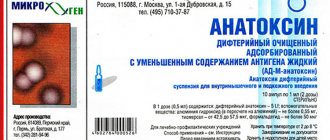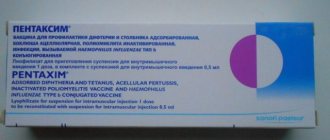Exudative diathesis - we act comprehensively
Notes from old newspapers help to assess the scale of the incidence of diphtheria in ancient times. Thus, the St. Petersburg Gazette in 1869 wrote that in two districts of the Don Army Region a “malignant toad” was rampant, from which children in huge numbers died within three days. There are farms where there are no children left at all. In the Khopyorsky district alone (now the territory of the Krasnodar Territory), 8,000 children died in a year.
How can a child become infected with diphtheria?
The diphtheria bacillus has the ability to dry out and persist for a long time in handkerchiefs, bedding, clothing, on toys and furniture, and in dust.
A child can become infected by contact with a sick person or with someone who is a carrier of the bacteria (the carriers themselves do not get sick, but they infect those around them).
Important! Children become infected more often in groups through direct contact with sick people or carriers, as well as through toys, clothes, poorly washed dishes and unprocessed foods.
Population immunization
Currently, immunization of the population is the most effective way to prevent the occurrence of diphtheria. Immunization is carried out by administering the vaccine against diphtheria, whooping cough, tetanus (DTP) in 3 stages:
- first vaccination at 3 months;
- second vaccination at 4.5 months;
- third vaccination at 6 months.
Next, revaccination of the population is carried out:
- first – at 18 months;
- the second - at 7 years old;
- the third - at 14 years old.
Afterwards, all adults undergo revaccination against diphtheria every 10 years from the date of the last revaccination.
How does diphtheria manifest in children?
The disease can affect the eyes, nasal mucosa and skin, but in 99% of cases, diphtheria in children manifests itself as a sore throat.
The child becomes very pale and weak. Body temperature rises to 38 degrees Celsius (it is at this point that diphtheria bacilli multiply well). Quite quickly the baby’s well-being deteriorates, visible swelling of the neck and difficulty swallowing appear. In the mouth of the baby, characteristic “fibrinous” deposits are visible: smooth, gray, shiny. They protrude beyond the tonsils and often creep onto the soft palate. If we could look further, we would see: the plaque goes deep down, covering the walls of the trachea and bronchi. With such a picture, it seems strange that the throat almost does not hurt. The explanation is simple: the diphtheria bacillus, so as not to be detected for as long as possible, anesthetizes the place of its attachment to the tissues.
Note: a child with diphtheria dies by suffocating with films, or from complications of the heart, kidneys, or adrenal glands.
There are diphtheria of varying degrees of severity - first, second and third. Doctors focus on the prevalence of swelling of the cervical tissue:
- to the middle of the neck - I degree;
- to the collarbones - II;
- below the collarbones - III.
Diagnostics
Diphtheria is diagnosed based on clinical manifestations and laboratory data. Among the clinical symptoms, an important sign for diagnosis is taken into account: the presence of a characteristic dense fibrinous film that is difficult to remove.
Laboratory methods used:
- a blood test to check for the presence of diphtheria antitoxin in the child’s blood;
- bacterioscopic: detection of corynebacteria under a microscope in a smear from the affected area;
- a bacteriological method that allows you to isolate diphtheria bacilli from a smear taken from the affected area.
A fact confirming the diagnosis is also the reverse development of all manifestations of diphtheria just one day after the intravenous infusion of anti-diphtheria serum.
How dangerous is diphtheria for a child?
A child who is fully vaccinated against diphtheria will have a minor sore throat without any complications. An unvaccinated person will most likely die. If the parents take the baby to the hospital on time, he will have a chance to survive, but he may never become completely healthy. Classic diphtheria is complicated by myocarditis, nephritis, and damage to the nervous system. One of the frequent consequences for many years after the disease is paresis of the soft palate in which the child cannot swallow water - it pours out through his nose.
Complication
In children, diphtheria can cause severe complications, especially in babies, caused by exposure to diphtheria bacillus toxins on the body and late administration of serum:
- myocarditis (inflammation of the heart muscle);
- toxic kidney damage leading to the development of hepatitis and nephritis;
- peripheral paralysis due to damage to the cranial nerves (paralysis of the soft palate, strabismus, paresis of the limbs, in severe situations - paralysis of the respiratory muscles);
- pneumonia in a child;
- decreased vision or blindness as a result of damage to the eyeballs;
- infectious-toxic shock;
- DIC syndrome (severe disorder of the blood coagulation system).
How is diphtheria treated in children?
It is important to hospitalize the child as quickly as possible.
Antibiotics will not help with the toxic form of diphtheria. The main method of treatment is the administration of anti-diphtheria serum (ADS), the dose and route of administration of which is calculated by the doctor individually. A complex of symptomatic treatment is carried out to help the child cope with the disease, and special nutrition is prescribed.
For non-toxic diphtheria, erythromycin and tetracycline work well. A seven-day course completely relieves the patient of the disease or carriage.
Treatment of the disease
Corynebacterium most often affects children aged 3-7 years, but you can get diphtheria at any age. Recently, cases among adults have become more frequent. Those who have reduced immunity and chronic diseases are especially at risk. Sick people are subject to hospitalization in an infectious diseases hospital, their contacts with the outside world are kept to a minimum in order to prevent further spread of the infection.
A patient with a confirmed diagnosis is injected intramuscularly with anti-diphtheria serum. It prevents the toxin from getting inside the cells. The dosage depends on the severity of the disease:
- for mild forms – 20-40 thousand IU;
- with average – 50-80 thousand IU;
- for severe cases - 90-150 thousand IU, of which 2/3 doses are administered at a time.
Next, antibiotics are prescribed, which are taken for 10-14 days. Local therapy is also indicated - rinsing the throat and nose with special solutions.
For moderate and severe forms of diphtheria, detoxification therapy is carried out with glucose-saline solutions, and glucocorticosteroids are also prescribed. Meals during treatment should be high in calories and fortified. Dishes that have undergone sufficient heat treatment are allowed.
Patients who are carriers of the infection are prescribed a course of antibiotics and restorative therapy.
The last two days of the incubation period and the entire height of the disease, the person poses a threat to others. Even if appropriate treatment is given, it will remain a source of infection for at least four days. And if the disease was mild and the person did not receive anti-diphtheria serum, he is dangerous to others even 2-3 weeks after the symptoms disappear.
Procedures for the treatment of diphtheria
For diphtheria, various thermal procedures are indicated. Heat not only has a general soothing effect and reduces soreness, but also (and this is very important) can lead to a reflex relaxation of the laryngeal muscles and thus eliminate the stenosis. In addition, warmth significantly improves sleep quality. A child with diphtheria croup can be prescribed general warm baths, wraps, paraffin treatment and ozokerite treatment (on the anterior and lateral areas of the neck). Since heat helps a sick child fall asleep, heat treatments should be performed before going to bed. Another clinical recommendation for diphtheria is the use of steam inhalation. For them, soda solution can be used, as well as infusions and decoctions of various medicinal plants that have antiseptic, anti-inflammatory, antispasmodic and sedative (calming) effects. It should be noted that some young children refuse to do inhalations - they are afraid of this procedure and are worried during its implementation, which can only intensify laryngeal stenosis and worsen the severity of the condition. If this is the case with a particular baby, then it is better not to give him inhalations. For children aged 4-5 years, such recommendations for diphtheria can be very helpful.
In some cases, the doctor may resort to treating a patient with true croup using fresh cold air. The child can be placed on the veranda or in front of a wide open window. Usually, when inhaling cold air, the symptoms of stenosis weaken, and the sick child calms down. Fresh cold air therapy sessions can last for several hours. It is recommended that the child even sleep in the fresh air. However, it is necessary to observe certain conditions: the child must be warmly dressed or wrapped up; The session should not be performed immediately after receiving thermal procedures. Treatment with fresh cold air does not help all patients. Other children only get worse from inhaling cold air, so resorting to this therapy without the knowledge of the attending physician is not recommended. Only a doctor who takes into account the individual characteristics of the patient can decide whether treatment with fresh cold air is indicated or not for a given child suffering from croup.
Regular suction of mucus and films from the respiratory tract greatly alleviates the child's condition with croup. The procedure is performed by a doctor using an electric suction and under laryngoscopy control.
If a sick child, despite all conservative measures, develops severe stenosis, surgical treatment is used: the doctor performs intubation or tracheotomy.
Prevention
Vaccination against diphtheria begins at three months of age.
To prevent diphtheria, the following activities are carried out:
- immunization (vaccination) of the entire population;
- isolation of patients;
- identification, isolation and treatment of diphtheria bacillus carriers;
- monitoring contact children.
A reliable and important preventive measure to protect against diphtheria is vaccination. Vaccinations are carried out with diphtheria (weakened) toxin, which is part of the diphtheria-tetanus-pertussis vaccine (DPT) or diphtheria-tetanus toxoid (DT).
Children are vaccinated from the age of three months: the drug is injected into the muscle three times with an interval of one and a half months. Revaccination is carried out at 1.5-2 years and at 7 and 14 years.
As prescribed by the pediatrician (if the child has contraindications to DPT and ADS), vaccination is carried out with more gentle preparations (they have a reduced antigen content): ADS-M-toxoid or AD-M-toxoid is administered 2 times according to an individual schedule.
On the day of vaccination, the child may experience a rise in temperature, malaise, slight redness and hardness at the injection site.
Patients with diphtheria are isolated for 7 days. Isolation is terminated upon receipt of a negative bacteriological test (smear from the mucous membranes of the nose and throat). Disinfection is carried out at the source of infection. Contact persons are monitored and examined for 7 days (a swab is taken from the nose and throat for bacteriological examination).
Treatment of diphtheria with antibiotics and conservative therapy
Antibacterial therapy plays an important role in the complex treatment of a patient with diphtheria. The fact is that antitoxic serum for diphtheria, no matter how early it is applied, does not directly affect the causative agent of the disease. Diphtheria bacilli continue to live in the body and release exotoxin into it. Traveling through the body with the blood, diphtheria bacilli enter various organs and have a pathogenic effect on them. In order to destroy the pathogen, the patient is prescribed antibiotics against diphtheria, and antibacterial therapy is also carried out to destroy the secondary coccal flora and, thus, to prevent life-threatening complications. Depending on the indications, the doctor may prescribe the child antibiotics for the treatment of diphtheria, such as penicillin, streptomycin, as well as broad-spectrum antibacterial drugs.
For croup, measures are taken against airway stenosis. First, they resort to conservative measures. If they are ineffective, surgery is indicated.
Conservative therapy begins with organizing complete rest for a child suffering from croup. Any factors that irritate or worry the child should be excluded. Mom or other close people caring for a sick child should in every possible way distract his attention from his condition - play with him, show him new toys, pictures in books, tell fairy tales and entertaining stories, draw, sculpt, etc. Sleep has a beneficial effect on the condition of a child (especially impressionable and easily excitable ones).











